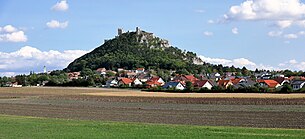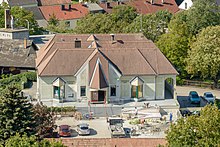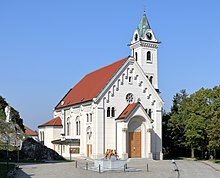Staatz
|
market community Staatz
|
||
|---|---|---|
| coat of arms | Austria map | |
|
|
||
| Basic data | ||
| Country: | Austria | |
| State : | Lower Austria | |
| Political District : | Mistelbach | |
| License plate : | MI | |
| Main town : | Staatz-Kautendorf | |
| Surface: | 42.65 km² | |
| Coordinates : | 48 ° 40 ′ N , 16 ° 29 ′ E | |
| Height : | 246 m above sea level A. | |
| Residents : | 1.911 (January 1, 2020) | |
| Population density : | 45 inhabitants per km² | |
| Postal code : | 2134 | |
| Area code : | 02524 | |
| Community code : | 3 16 49 | |
| NUTS region | AT125 | |
| Address of the municipal administration: |
Neudorfer Strasse 7 2134 Staatz |
|
| Website: | ||
| politics | ||
| Mayor : | Daniel Fröschl ( ÖVP ) | |
|
Municipal Council : ( 2020 ) (19 members) |
||
| Location of Staatz in the Mistelbach district | ||
 Northwest view of Staatz-Kautendorf with the 100 m high limestone cliff visible from afar |
||
| Source: Municipal data from Statistics Austria | ||
Staatz is a former township and today's market town with 1911 inhabitants (as of January 1, 2020) in the Mistelbach district in Lower Austria .
geography
Staatz is located in the Weinviertel in Lower Austria. The area of the market town covers 42.63 square kilometers. 12.48 percent of the area is forested.
Community structure
The municipality includes the following six localities (population in brackets as of January 1, 2020):
- Ant (317)
- Enzersdorf near Staatz (352)
- Ernsdorf near Staatz (163)
- Staatz-Kautendorf (570)
- Waltersdorf near Staatz (159)
- Wultendorf (350)
The community consists of the cadastral communities Ameis, Enzersdorf bei Staatz, Ernsdorf, Staatz-Kautendorf, Waltersdorf and Wultendorf.
The community belongs to the small region of Land um Laa .
On January 1, 1966, the formerly independent communities Ameis, Enzersdorf bei Staatz, Ernsdorf bei Staatz, Waltersdorf bei Staatz, Wultendorf were incorporated into Staatz.
Neighboring communities
history
The history of the market town of Staatz is closely linked to the castle ruins of the same name. Staatz Castle was built in the 11th century; the first documentary mention is in 1072. A Reginger von Staatz appeared in the years from 1125 to 1137 . In the years from 1178 to 1198 Odalrich von Staatz and his sons Otto and Pilgrim are mentioned. Around the year 1200 Reinger and Eberwein are mentioned by Staatz. Ulrich II von Staatz is mentioned until 1230. The male sex of the Staatzer probably ended around the middle of the 13th century. In the further course of the Middle Ages , the place and its castle were the scene of armed conflicts several times. In the first half of the 16th century Staatz came to the barons of Roggendorf . In 1551 the rule of Staatz was pledged by the sovereign, Emperor Ferdinand I , to the Barons von Breuner , who expanded the castle. Towards the end of the Thirty Years War , the castle was destroyed by a Swedish army in 1645. It has been in ruins ever since . The Counts of Breuner built a new castle between 1645 and 1672 at the eastern foot of the castle rock, which was rebuilt in 1807 by Count Colloredo.
In the years from 1454 to 1590 Staatz had 20 houses.
In the last days of the Second World War , Staatz and its cadastral communities became the scene of violent and eventful battles between troops of the Wehrmacht and the Red Army . In Staatz itself, heavy damage was caused by artillery fire, civilians were also killed and numerous buildings were destroyed by fire. Heavy fighting took place in Ernsdorf between April 19 and 24, 1945, in which 12 tanks were shot down and two civilians were killed. On April 22nd, Russian soldiers marched into Ernsdorf, looted the place and confiscated almost all of its livestock and food. A businessman from Ernsdorf reported that rape was the order of the day, and a woman is said to have been abused 36 times in just one night. Fighting also took place in Enzersdorf, where at least two civilians were also killed. Due to the war events in 1945, the castle also burned down and had to be demolished. Only the Schüttkasten (today the Musikvereinssaal) and two residential buildings are preserved.
Population development
According to the results of the 2001 census, there were 2065 inhabitants. In 1991 the market town had a population of 2012, in 1981 it had 2059 and in 1971 it had a population of 2125.
politics
The municipal council has 19 members.
- With the municipal council elections in Lower Austria in 1990, the municipal council had the following distribution: 16 ÖVP and 5 SPÖ.
- With the municipal council elections in Lower Austria in 1995, the municipal council had the following distribution: 14 ÖVP, 6 SPÖ and 1 FPÖ.
- With the municipal council elections in Lower Austria in 2000, the municipal council had the following distribution: 14 ÖVP, 6 SPÖ and 1 FPÖ.
- With the municipal council elections in Lower Austria in 2005 , the municipal council had the following distribution: 14 ÖVP and 7 SPÖ.
- With the municipal council elections in Lower Austria in 2010 , the municipal council had the following distribution: 13 ÖVP and 8 SPÖ. (21 members)
- With the municipal council elections in Lower Austria in 2015 , the municipal council had the following distribution: 10 ÖVP and 9 SPÖ.
- With the municipal council elections in Lower Austria 2020 , the municipal council has the following distribution: 14 ÖVP and 5 SPÖ.
- mayor
- 1995–2017 Leopold Muck (ÖVP)
- since 2017 Daniel Fröschl (ÖVP)
Culture and sights
- Staatzer Klippe : The Jurassic limestone piercing cliff is a remarkable natural monument.
- Staatz castle ruin : The ruin stands on the top of the cliff.
- Staatz Felsenbühne : The Staatz Felsenbühne , located at the foot of the Staatz mountain, has been the venue for the annual summer festival since 2000.
- Catholic parish church Ameis hl. Nicholas
- Catholic parish church Staatz hl. Martin
- Catholic parish church Wultendorf hl. Kunigunde
- Loahmgstettn: A cellar village in Ameis that won the cellar lane competition in 1998, making it one of the most beautiful cellar lanes in the country.
- Dorfwiazhaus: The Ameiser village center. The around 100 year old Stadler village inn was revitalized by the ants after a 30-year slumber. In 2011, the Ameiser received the Golden Trowel, the highest award for building design in Lower Austria, from the state of Lower Austria.
economy
In 2001 there were 68 non-agricultural workplaces, agricultural and forestry businesses according to the 1999 survey 134. The number of people in work at home was 921 according to the 2001 census. In 2001, the activity rate was 45.85 percent.
Web links
- Staatz
- 31649 - Staatz. Community data, Statistics Austria .
Individual evidence
- ↑ Statistics Austria: Population on January 1st, 2020 by locality (area status on January 1st, 2020) , ( CSV )
- ↑ Changes to the community from 1945 (associations, partitions, name and status changes). Statistics Austria, p. 22 , accessed on February 11, 2019 .
- ^ Kurt Klein: Settlement Growth and Housing Stock in Lower Austria in the Late Middle Ages . S. 42 ( Online [PDF; 5.9 MB ; accessed on May 23, 2020]).
- ^ Army History Museum / Military History Institute (HGM / MHI) , Military History Research Department (MilFoA), study collection, inventory 1945, box 5, fasc. 45/9, municipality reports Lower Austria, District Mistelbach
- ^ Election result of municipal council elections 1995 in Staatz. Office of the Lower Austrian State Government, March 30, 2000, accessed on March 2, 2020 .
- ^ Election result of the municipal council election 2000 in Staatz. Office of the Lower Austrian State Government, February 4, 2005, accessed on March 2, 2020 .
- ^ Election results for the municipal council election 2005 in Staatz. Office of the Lower Austrian State Government, March 4, 2005, accessed on March 2, 2020 .
- ^ Election result of the municipal council election 2010 in Staatz. Office of the Lower Austrian State Government, October 8, 2010, accessed on March 2, 2020 .
- ^ Election results for the 2015 municipal council elections in Staatz. Office of the Lower Austrian State Government, December 1, 2015, accessed on March 2, 2020 .
- ↑ Results of the municipal council election 2020 in Staatz. Office of the Lower Austrian State Government, January 26, 2020, accessed on March 2, 2020 .
- ↑ http://dorfwiazhaus.ameis.at/ accessed on May 10, 2011











